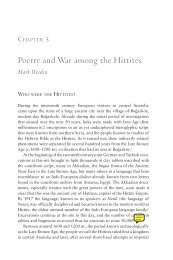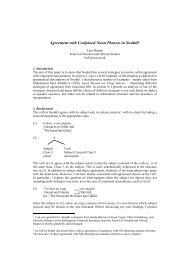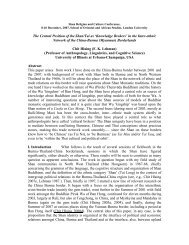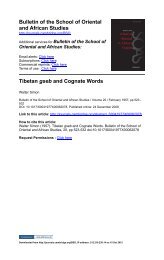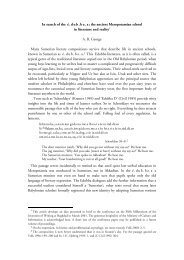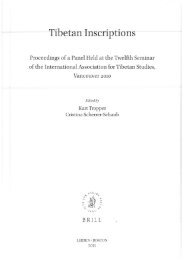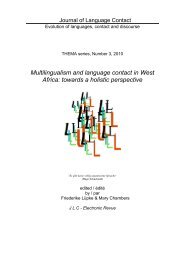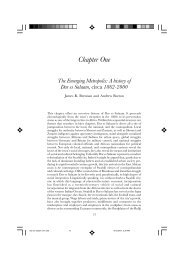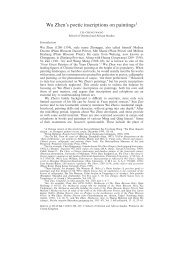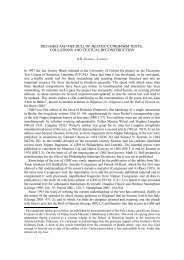Download (316Kb) - SOAS Research Online - The School of ...
Download (316Kb) - SOAS Research Online - The School of ...
Download (316Kb) - SOAS Research Online - The School of ...
You also want an ePaper? Increase the reach of your titles
YUMPU automatically turns print PDFs into web optimized ePapers that Google loves.
250 almut hintze<br />
Burrow 1957a, 136 f. objects to Bailey’s supposition <strong>of</strong> a variant ghar on the<br />
grounds that har ‘to take’ forms a perfect jahāra. 12 Instead, he posits another<br />
new root ghar ‘to whirl, brandish, swing (a weapon)’ with a past participle ghūrn. a-<br />
‘whirled, brandished, swung’ 13 for those passages discussed by Bailey where the<br />
meaning <strong>of</strong> ghar, jígharti appears difficult to reconcile with ghar ‘to sprinkle’.<br />
Burrow further objects that Bailey does not account for Ved. gar i ‘to raise (one’s<br />
hand or weapon preparatory to striking)’ which would go very well with Greek<br />
ÐÐÛ and also yield a reasonable equivalent <strong>of</strong> Av. gar in niγrāire. Consequently<br />
he retains the old equation <strong>of</strong> Av. gar in niγrāire with the Vedic verb gar i (gur ),<br />
whose meaning he posits as ‘to propel’.<br />
<strong>The</strong> only alleged Avestan cognate <strong>of</strong> this root, Yt 10.40 niγrāire, is eliminated<br />
by Insler 1967. Elaborating on an earlier suggestion by Windischmann, 14 he<br />
emends niγrāire to x niγnāire, thus retrieving a 3pl. stative <strong>of</strong> the common root<br />
jan ‘to slay’, <strong>of</strong> which a 3sg. stative niγne is attested in Yt 10.104 (= Y 57.29). 15<br />
Insler argues that the transmitted form niγrāire involved a scribal error “due to<br />
the very close orthographic similarity between the signs for r and n in the Avestan<br />
script system” (p. 262). He does not, however, adduce examples <strong>of</strong> the alleged<br />
confusion <strong>of</strong> the signs. Instead, he supports his emendation with a syntactic<br />
argument. In Vedic, the verb ni-han may participate in three different syntactic<br />
figures. In the most common, the weapon utilized is in the accusative as the<br />
object <strong>of</strong> the verb while the person or bodily part struck with the weapon is in<br />
the locative. Since this syntactic construction is also found in Yt 10.40 and 101,<br />
Insler reconstructs an Indo-Iranian expression *ni tásmi vá´zram jhanti ‘he strikes<br />
the cudgel down on him’ (p. 264).<br />
<strong>The</strong> proposal yields a text which is immaculate, syntactically plausible and<br />
with a verbal form fitting well into the paradigm <strong>of</strong> the root jan ‘to slay’. But<br />
perhaps the strongest argument in favour <strong>of</strong> the emendation is, as pointed out<br />
by Insler, ibid. 260 f., the fact that the distribution <strong>of</strong> the old stative ending<br />
-āre/-re is very limited in Avestan. Apart from the disputed form, there are only<br />
o mruuāire from mrū ‘to speak’, sōire (= Ved. ´sére) fromsi ‘to lie’ and ˚āÒh ˘āire<br />
from āh ‘to sit’. 16 While statives <strong>of</strong> these three roots and <strong>of</strong> jan ‘to slay’ are well<br />
documented, such a formation would be difficult to justify for an isolated root gar<br />
‘to raise (one’s hand or weapon preparatory to striking)’ otherwise unattested in<br />
12 Along similar lines, Mayrh<strong>of</strong>er, EWAia II 804 comments that har probably does not<br />
have forms with *ghar.<br />
13 More details on this are given by Mayrh<strong>of</strong>er, EWAia I 515.<br />
14 Windischmann, Mithra 35.<br />
15 A full list <strong>of</strong> references to Insler’s predecessors adopting this interpretation is given by<br />
Kellens, Noms-racines 152 n. 3. <strong>The</strong> emendation is favourably considered by him,<br />
Verbe av. 164, and accepted, for instance, by Kümmel, Stativ und Passivaorist 147 and<br />
in LIV 186 n. 1.<br />
16 H<strong>of</strong>fmann/Forssman p. 203.



